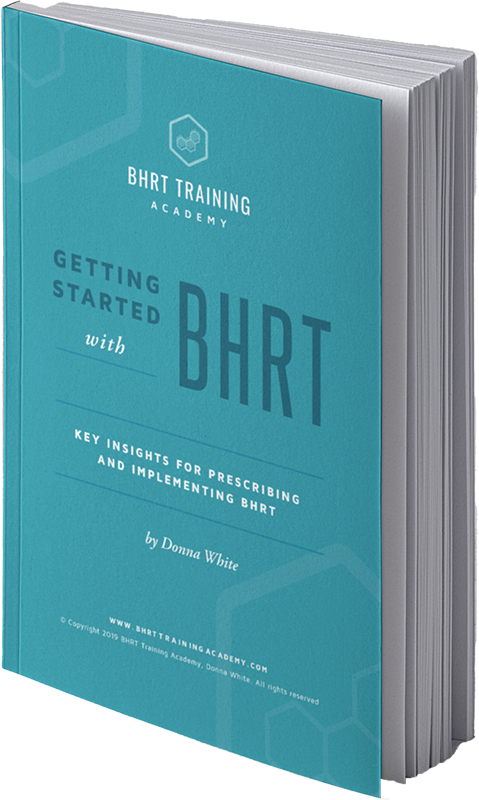What is BHRT – 5 Basics to Help You Talk to Your Patients

There is a lot of literature surrounding Hormone Replacement Therapy (HRT) and Bioidentical Hormone Replacement Therapy (BHRT), and a lot of confusing information on the internet. Your patients may have a lot of questions, and you want to be able to answer them confidently.
So what is BHRT, exactly, and how is it different from traditional HRT?
To put it very simply, BHRT is an alternative prescription to the traditionally prescribed HRT. But there’s much more to it. The following five talking points can help you address the common questions that patients may be asking you if they are considering BHRT.
What is BHRT? Talking Point #1: Bioidentical hormones are identical to those produced in the body.
Unlike HRT, BHRT uses hormones that are chemically and structurally identical to those naturally produced in the body. Since these hormones have exactly the same molecular configuration as those produced endogenously, they perform the same functions.
Also, bioidentical hormones undergo the same conversions as endogenous hormones. This means they are converted into other downstream hormones as well as the same important metabolites as endogenous hormones; a well-known example of this is human recombinant insulin.
What is BHRT? Talking Point #2: Bioidentical hormones are plant-derived.
Hormones traditionally used in HRT are either animal-derived or synthetic.
However, bioidentical hormones are derived from plants, specifically yam or soy.
Through a series of chemical processes, a plant molecule called diosgenin, which is structurally similar to a steroid hormone, is converted to the specific human hormone molecule in a laboratory.
The result of this process is a hormone that has no further trace of the original plant molecule but is a pure biologically identical United States Pharmacopeia hormone.
This hormone is then used in either manufactured pharmaceutical medications or by compounding pharmacies who prepare patient-specific hormones.
BHRT fits beautifully in plastic surgery or aesthetic medical practices. Click here to find out more.
What is BHRT? Talking Point #3: BHRT is effective.
A main question doctors receive about BHRT is, is it effective? Many experts say, yes. From a clinical standpoint, BHRT can be especially effective for women and men who are experiencing symptoms of hormone imbalance or hormone deficiency.
These patients can present with myriad symptoms of dis-ease, such as PMS, unmanageable perimenopausal and menopausal symptoms, androgen deficiency in men, and many other conditions such as:
- Insomnia
- Mood disorders
- Low sex drive
- Metabolic syndrome
- Migraines
- Obesity
- Fatigue
- Hypothyroidism
- Bone loss
- Uterine fibroids
- Fibrocystic breasts
- Skin disorders
- PCOS
- Chronic Fatigue Syndrome
- Hirsutism
- Connective tissue disorders
This list is extensive but it is certainly not exhaustive.
What is BHRT? Talking Point #4: How BHRT is implemented.
BHRT is generally initiated after a hormone consultation with the patient. Before treatment begins, each bioidentical hormone patient’s individual hormone status is assessed and hormonal imbalances and deficiencies are determined. Based on their medical history, symptoms, and lab testing results, a protocol is then individually tailored and prescribed for each patient.
This protocol is then implemented and over the course of therapy is modified or titrated according to progressive clinical and lab results. Hormone balancing treatment consists of l BHRT prescriptions, supplements, dietary changes, and positive lifestyle modifications. After initiating therapy, patients are given lab orders for repeat testing and are scheduled for follow up care to monitor their progress in 1-3 months. Monitoring and repeat testing may be conducted every 3-6 months, and semi-annual evaluations begin following the resolution of the initial symptoms.
Also, patients often require further therapy adjustments after such events as periods of stress, significant weight loss or gain, or as the patient’s natural hormone levels shift.
What is BHRT? Talking Point #5: How is this treatment administered?
Depending on which type of treatment the administering physician decides upon, bioidentical hormone prescriptions can be prescribed through conventional pharmacies or compounded pharmacies. Prescriptions from conventional pharmacies are FDA approved. Examples of these types of prescriptions are estradiol patches or pills, testosterone patches and gels, and progesterone pills.
The hormone prescriptions available through compounding pharmacies do not require
FDA approval. These hormones are custom compounds formulated by the physician and are compounded at these pharmacies. While the compound itself is not FDA approved, these pharmacies only use hormones from FDA-registered and inspected facilities, such as the Professional Compounding Centers of America (PCCA). While FDA approval is required for mass-produced drugs made by larger manufacturers, it is not possible for each compounded formulation to go through the FDA’s drug approval process since each prescription is personalized for each patient.
As a medical provider, you are on the front lines every day meeting the needs of your patients. Hormone therapy and BHRT are complex topics and patients and their loved ones typically have a lot of questions.
There is a lot of conflicting, confusing information about BHRT on the internet. In order to prevent your patients from relying on this unreliable source of information, these simple talking points can help break down the basics of this therapy for them. When you are equipped to answer their questions correctly and in a knowledgeable manner, your patients can confidently rely on you to guide them.
Ready to learn more about how BHRT could fit into your practice? Click here to schedule a strategy call and get started.
Enjoyed this article? Here are three more to help you:
BHRT is a star player in the billion-dollar anti-aging industry.
Thinking about starting a BHRT practice? Here are 7 things to consider.

Get the quick read ebook,
Getting Started with BHRT -
Key Insights to Prescribing and Implementing BHRT.
CME's - Earn while you learn.
